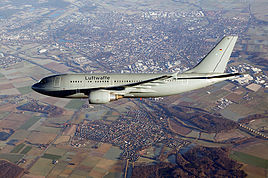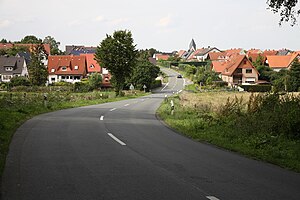Wewer
|
Wewer
City of Paderborn
Coordinates: 51 ° 41 ′ 18 ″ N , 8 ° 41 ′ 52 ″ E
|
|
|---|---|
| Height : | 132 m above sea level NN |
| Area : | 16.88 km² |
| Residents : | 7625 (Jul 26, 2019) |
| Population density : | 452 inhabitants / km² |
| Incorporation : | 1st July 1969 |
| Postal code : | 33106 |
| Area code : | 05251 |
|
Location of the Wewer district in Paderborn
|
|
|
Aerial view of Wewer, behind it Paderborn
|
|
Wewer is a south-western district of Paderborn in the east of North Rhine-Westphalia and has about 7100 inhabitants. Until 1969, Wewer was an independent municipality in the Kirchborchen office , which merged with the city of Paderborn on July 1, 1969.
geography
Geographical location
Wewer is at 51 ° 41 'N. Br. And 8 ° 42' E. L. in the southeast of the Westphalian Bay and belongs mainly to the eastern Hellweg area . The parts of the village to the east of the Alme lie on the Paderborn plateau .
Expansion of the village
Wewer covers an area of 16.88 km², with the north-south and west-east extension of the district each about 6 km. The highest point of the village with 176.6 m above sea level. NN is on the eastern edge of the district to the Paderborn industrial area Mönkeloh, the deepest in the Almetal on the border with the city center and Elsen.
Neighboring places
Starting in the north in a clockwise direction, the Paderborn core town and the Elsen district , the Borchen districts Nordborchen and Alfen and the Salzkotten districts Oberntudorf and Scharmede , all of which belong to the Paderborn district, border on Wewer .
Local division
To the east of the Alme and the A 33 is the small hamlet of Barkhausen. The once free area around this is being built over more and more by commercial areas that seamlessly merge into the commercial and industrial areas of Paderborn city center located to the north and east. Gut Warthe is located north of Bundesstraße 1.
history
Wewer was first mentioned in 835 in a document from the Corvey monastery . At that time the village was called Wawuri . In the 12th century it was known as Waveri . The Wevere ministerial family can be traced back to the end of the 12th century .
The Alte Burg an der Alme came into the possession of the von Brenken family in 1515 and was expanded as the family seat in 1690. The baroque castle from the 17th century is a reminder of the extinct von Imbsen family, whose heirs sold it to the von und zu Brenken family in the 19th century.
On April 1, 1945, US troops occupied Paderborn. On April 2nd there was fierce fighting in Wewer; around 40 Wehrmacht soldiers and four US soldiers died. Three Sherman tanks were shot down.
With the "Law on the integration of the municipality of Wewer, district of Paderborn, into the city of Paderborn" of June 24, 1969 the area change agreement between the city of Paderborn and the municipality of Marienloh of February 28, 1969 was largely confirmed and the previously independent and the office Parish belonging to Kirchborchen incorporated into the city of Paderborn on July 1, 1969.
Religions
The majority of the population in Wewer is Catholic and belongs to the Catholic parish of St. Johannes Baptist in the Paderborn deanery, Archdiocese of Paderborn .
The Evangelical Lutheran residents of Wewers belong to the Stephanus parish in neighboring Borchen .
Population development
- 1950: 2265 inhabitants
- 1961: 2477 inhabitants
- 2010: 6792 inhabitants
- 2012: 6912 inhabitants
- 2013: 6933 inhabitants
- 2016: 7127 inhabitants
- 2019: 7625 inhabitants
politics
City council elections
In the last local election on May 25, 2014, the citizens of Weweran cast their votes in the election for the Paderborn city council as follows:
- CDU : 46.58% (+ 8.44%)
- SPD : 26.68% (+ 4.65%)
- Greens : 12.34% (+ 1.78%)
- FDP : 7.08% (- 12.93%)
- FBI (Free Citizens' Initiative Paderborn) : 3.53% (- 0.28%)
- DIP (Democratic Initiative Paderborn) : 2.85% (- 2.60%)
- Alternative for Germany : 0.95% (+ 0.95%)
Council representatives for Wewer in the 2014–2020 legislative period are Matthias Dülme (CDU), Alexander Jacobs (CDU) and Claudia Steenkolk (SPD).
Mayor
Wewer's mayor is Volker Odenbach ( CDU ).
Culture and sights

The painter Franz Thöne was born on the Stellbrinkshof in Wewer on February 4, 1851. He attended the Düsseldorf Art Academy from 1871 and established himself as a genre and portrait painter in the state capital. He is one of the artists at the Düsseldorf School of Painting . Franz Thöne was married to Maria Vössing, the daughter of the Weweran teacher Johann Vössing.
In 2015, a memorial stone was erected for the Wewersche poet Elisabeth Poganiuch-Flören (1907–1982) in the Wewersche cemetery. From Professor Dr. Bernhard Sill, parts of their works were published.
Numerous events take place in the Bürgerhaus Wewer every year.
Buildings
The origins of the oldest buildings are the Catholic Church and the Old Castle on the Alme. Above the Alme, the von Imbsen family had the baroque Wewer Castle built from 1684 as a successor to an older castle. The historical significance of the Warthe am Hellweg estate and the former guard tower of the municipal Landwehr is no longer visible after the reconstruction of Bundesstraße 1. The well-preserved building stock is also endangered by the cutting of the site.
nature
The Ziegenberg east of the Alme / Lohne is under nature protection.
As a connection between the original village of Wewer and the forest, the impressive oak avenue, some of which is still six-row today, was laid out in the 19th century.
In the northern area of Wewer, after the expansion of the B 1, which was completed in 2012, there is considerable interference in the natural balance due to the lowering of the groundwater and the loss of large arable land.
Further interventions in nature and the landscape surrounding the Wewer were made through the construction of wind turbines.
Sports
For the sporty Wewerans there is a fitness studio and the Elsen-Wewer running club (TuRa Elsen). The largest sports club in Wewer, with around 800 members, is the Wewer 2000 sports club. It offers aerobics, leisure sports, gymnastics and table tennis. You can also play football at TSV Wewer. The club has two grass pitches, an ash pitch and an artificial turf pitch, with the ash pitch and artificial turf pitch having floodlights. Both sports clubs in Wewer, TSV Wewer and SC Wewer 2000, emerged from the insolvent SV Blau-Weiß Wewer .
Music band
The Wewer band, which originally emerged from the shooting club, has existed since 1949. In the past decades, the Wewer band has expanded its spectrum beyond marching music and operates as an independent band.
Archery
The St. Johannes and St. Hubertus Rifle Brotherhood Wewer 1910 have around 1200 members. The Weweraner rifle battalion consists of two rifle companies (Warthe company and castle company) from the following specialist departments:
- Shooting department in the Federation of Historic German Shooting Brotherhoods (HSB)
- Shooting group in the Westphalian Rifle Federation (WSB)
- Large caliber sport shooters Wewer eV
- Flag waver Wewer
- Young rifle division
- Spielmannszug Wewer: The year that the Spielmannszug was founded goes back to 1906.
Paderborn Minicar Club
Some RC-car enthusiasts founded the Paderborn Minicar Club (PMC) around 1980. Since then the PMC has been a member of the German Minicar Club. Training and driving took place in parking lots in Paderborn. After a training phase, the club members took part in DMC races. Some members were able to qualify to take part in runs for the German championship in the following years. The PMC hosts a variety of regional friendship races in different locations. For several years there has been an annual racing series (WinterCup) for electric vehicles in the community center in Wewer. The races mainly take place in the winter months. Recently the club has its own off-road track, on which remote-controlled vehicles can be used for training.
Economy and Infrastructure
The main customs office, which was formerly located on Paderborn Bahnhofstrasse and now in the Mönkeloh industrial area of Paderborn , has moved to the site of the truck stop at the Paderborn-Mönkeloh motorway junction and thus to the eastern outskirts of Wewers.
There is a three-class elementary school , the Almeschule. It is a school of the city of Paderborn and consists of two buildings.
literature
- Isa Freifrau von Elverfeldt: Wewer, Mein Heimatbuch , Volume I, Wewer-EDITION, 2011
- Isa Freifrau von Elverfeldt: Wewer, Mein Heimatbuch , Volume II, Wewer-EDITION, 2nd improved edition 2014
- Isa Freifrau von Elverfeldt: Die Ritter von und zu Brenken , Wewer Volume III, Wewer-EDITION, 2015
- Isa Freifrau von Elverfeldt: The Barons von and zu Brenken , Wewer Volume IV, Wewer-EDITION, 2015
- Isa Freifrau von Elverfeldt: The Barons von Imbsen , Wewer Volume V, Wewer-EDITION, 2016
- Isa Freifrau von Elverfeldt: Wewerscher Wald and Gut Wilhelmsburg , Wewer Volume VI, Wewer-EDITION, 2017
- Elisabeth Poganiuch-Flören: "Bright words without hat, delicate, little white sails", poems, edited by Bernhard Sill, Wewer-EDITION, 2014
- Elisabeth Poganiuch-Flören: "Be still, oh earth!", Advent and Christmas in poems and stories, introduced and edited by Bernhard Sill, Wewer-EDITION, 2016
Web links
- City-Portal Paderborn: Wewer
- Advertising association Wewer
- Catholic parish of St. Johannes Baptist Wewer
- Document registers from the general archive of Landsberg-Velen with holdings on Gut Wewer / digital Westphalian document database (DWUD)
- Wewer in the Westphalia Culture Atlas
Individual evidence
- ^ Stefan Westhoff: The end of the war in Paderborn: The last eleven days from March 22nd to April 1st, 1945. BoD paperback, ISBN 978-3837055870 , page 63.
- ↑ Martin Bünermann: The communities of the first reorganization program in North Rhine-Westphalia . Deutscher Gemeindeverlag, Cologne 1970, p. 102 .




